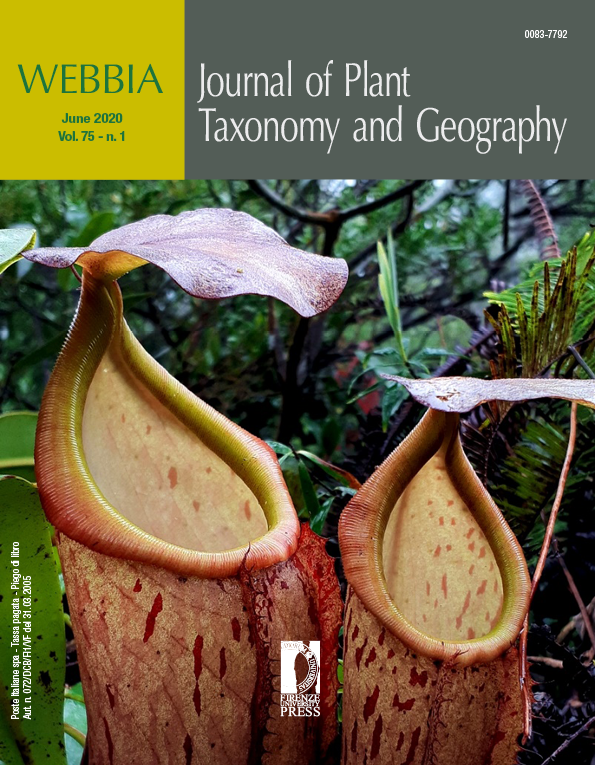Special section on Araceae
Studies on Potheae (Araceae) of Borneo II: Pedicellarum M.Hotta subsumed into Pothos L., and recognition of three new species
Published 2020-07-01
Keywords
- Borneo,
- Araceae,
- Potheae,
- Pedicellarum,
- Pothos
How to Cite
Wong , S. Y., Joling, J., Pereira, J. T. ., Damit, A., Boyce, P. C., & Hay, A. (2020). Studies on Potheae (Araceae) of Borneo II: Pedicellarum M.Hotta subsumed into Pothos L., and recognition of three new species. Webbia, 75(1), 89–103. https://doi.org/10.36253/jopt-7944
Abstract
Pedicellarum is subsumed into Pothos as Pothos paiei. Four species, three taxonomically novel (Pothos degenerans, ecclesiae and P. fractiflexus) and one pre-existing (Pothos oliganthus) are discussed. The reproductive structures are reinterpreted and floral terminology used in this paper is in line with paving the way to interpreting the ‘inflorescence’ of Pothos, and indeed of all other aroids, as a unique array of structures that are neither flowers nor inflorescences as defined by current prevailing orthodoxy, but something of both.
References
Boyce PC, Hay A. 2001. A taxonomic revision of Araceae tribe Potheae (Pothos, Pothoidium
and Pedicellarum) for Malesia, Australia and the tropical Western Pacific. Telopea. 9(3):449–457.
Boyce PC, Hay A. 2001. A taxonomic revision of Araceae tribe Potheae (Pothos, Pothoidium
and Pedicellarum) for Malesia, Australia and the tropical Western Pacific. Telopea. 9(3): 449–457.
Grayum MH. 1984. Palynology and phylogeny of the Araceae. Ph.D. Dissertation. Univ.
Massachusetts, Amherst, Massachusetts.
Grayum MH. 1990. Evolution and Phylogeny of the Araceae. Annals of the Missouri
Botanical Garden 77(4): 628–697.
Hay A & Mabberley DJ. 1991. ‘Transference of function’ and the origin of aroids: their
significance in early angiosperm evolution. Botanische Jahrbücher fur Systematik, Pflanzengeschichte und Pflanzengeographie. 113: 330–428.
Hay A. 2019. Durianology, discovery, and saltation: the evolution of aroids. Gardens’
Bulletin Singapore 71(Suppl. 2): 257–313.
Hotta M. 1976. Notes on Bornean Plants III: Pedicellarum and Heteroaridarum, two new
genera of the aroids. Acta Phytotaxonomica et Geobotanica 27(3-4): 61–65.
Mabberley DJ & Hay A. 1994. Homoeosis, canalization, decanalization, ‘characters’ and
angiosperm origins. Edinburgh Journal of Botany. 51: 117–126.
Moffett MW. 2000. What’s “Up”? A Critical look at the basic terms of canopy biology.
Biotropica 32(4a): 569–596.
Mayo SJ, Bogner J & Boyce PC. 1997. The Genera of Araceae. Royal Botanic Gardens, Kew
xi + 370 pp.
Nicolson DH. 1984. A second collection of Pedicellarum (Araceae) Aroideana 7(2): 56–57.
Tate RB. 2001. The geology of Borneo island CDROM. – Kuala Lumpur: Persatuan Geologi
Malaysia / Geological Society of Malaysia.
Zotz G. 2013. ‘Hemiepiphyte’: a confusing term and its history. Annals of Botany. 111(6):
1015–1020.
and Pedicellarum) for Malesia, Australia and the tropical Western Pacific. Telopea. 9(3):449–457.
Boyce PC, Hay A. 2001. A taxonomic revision of Araceae tribe Potheae (Pothos, Pothoidium
and Pedicellarum) for Malesia, Australia and the tropical Western Pacific. Telopea. 9(3): 449–457.
Grayum MH. 1984. Palynology and phylogeny of the Araceae. Ph.D. Dissertation. Univ.
Massachusetts, Amherst, Massachusetts.
Grayum MH. 1990. Evolution and Phylogeny of the Araceae. Annals of the Missouri
Botanical Garden 77(4): 628–697.
Hay A & Mabberley DJ. 1991. ‘Transference of function’ and the origin of aroids: their
significance in early angiosperm evolution. Botanische Jahrbücher fur Systematik, Pflanzengeschichte und Pflanzengeographie. 113: 330–428.
Hay A. 2019. Durianology, discovery, and saltation: the evolution of aroids. Gardens’
Bulletin Singapore 71(Suppl. 2): 257–313.
Hotta M. 1976. Notes on Bornean Plants III: Pedicellarum and Heteroaridarum, two new
genera of the aroids. Acta Phytotaxonomica et Geobotanica 27(3-4): 61–65.
Mabberley DJ & Hay A. 1994. Homoeosis, canalization, decanalization, ‘characters’ and
angiosperm origins. Edinburgh Journal of Botany. 51: 117–126.
Moffett MW. 2000. What’s “Up”? A Critical look at the basic terms of canopy biology.
Biotropica 32(4a): 569–596.
Mayo SJ, Bogner J & Boyce PC. 1997. The Genera of Araceae. Royal Botanic Gardens, Kew
xi + 370 pp.
Nicolson DH. 1984. A second collection of Pedicellarum (Araceae) Aroideana 7(2): 56–57.
Tate RB. 2001. The geology of Borneo island CDROM. – Kuala Lumpur: Persatuan Geologi
Malaysia / Geological Society of Malaysia.
Zotz G. 2013. ‘Hemiepiphyte’: a confusing term and its history. Annals of Botany. 111(6):
1015–1020.

